The Intel Haswell Refresh Review: Core i7-4790, i5-4690 and i3-4360 Tested
by Ian Cutress on May 11, 2014 3:01 AM ESTFor our discrete GPU benchmarks, we have split them up into the different GPU configurations we have tested. We have access to both MSI GTX 770 Lightning GPUs and ASUS reference HD 7970s, for SLI and Crossfire respectively. These tests are all run at 1080p and maximum settings, reporting the average and minimum frame rates.
dGPU Benchmarks: 2x MSI GTX770 Lightning
F1 2013


Despite the lack of scaling, moving to dual GPU puts a larger rift between the i3 and the other CPUs for average FPS in 2013.
Bioshock Infinite

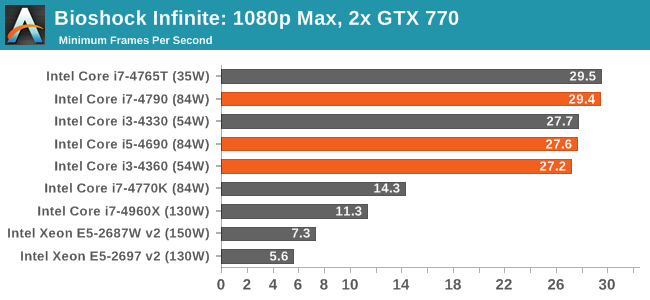
Tomb Raider
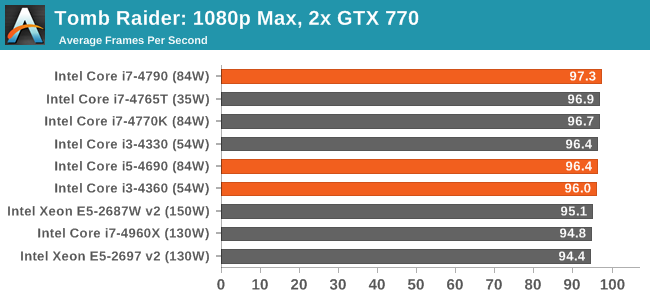
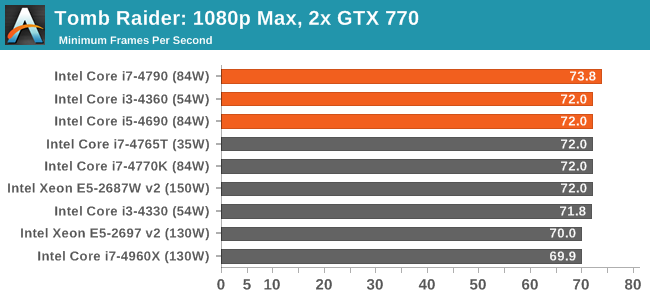
Sleeping Dogs
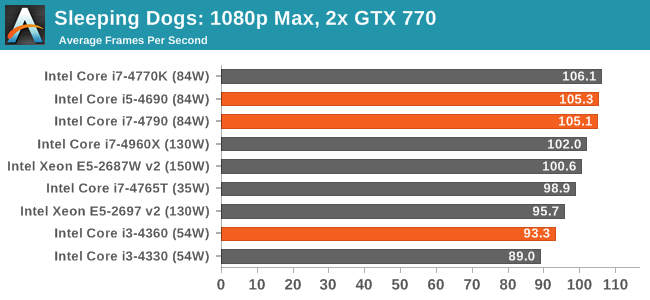
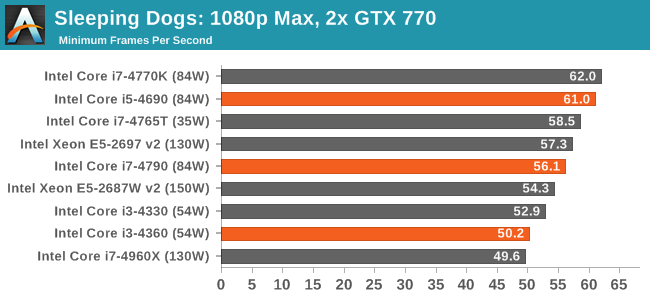
While average FPS takes a ~10% drop from i3 to i5, the same 10 FPS drop is seen in the minimum frame rates but this equates more to a ~20% decline.
Company of Heroes 2
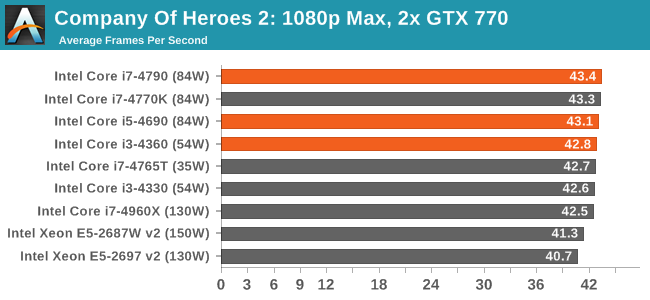
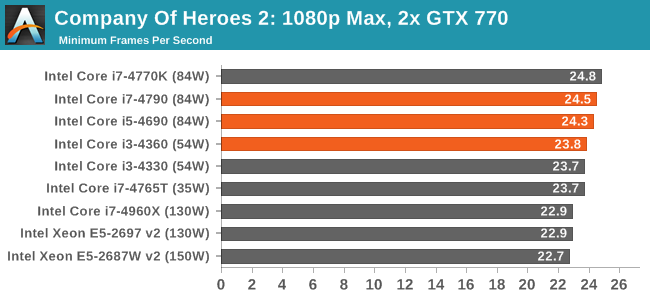
Battlefield 4
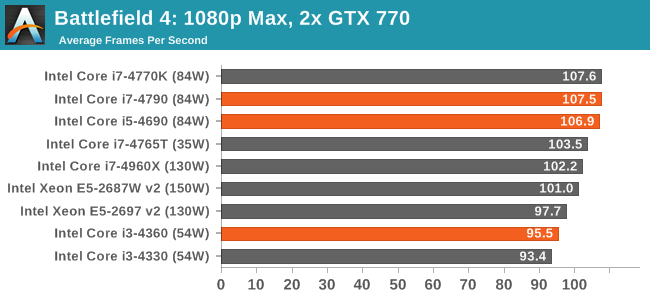
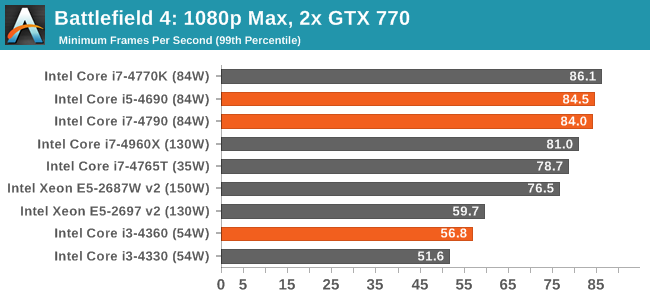
When you start adding the GPU horsepower, the i3 core count becomes a hindrance in minimum FPS values for BF4.










130 Comments
View All Comments
Ramon Zarat - Monday, May 12, 2014 - link
Whatever man... :/ You're happy with 7 seconds? I'm happy for you.Then again, this is such a *HUGE* issue, right? I mean, 25 seconds boot is a REAL *problem* right? But to think of it, 7 seconds is also wayyyy too long, right? This is why 95% of my boot are 55% faster than yours, in only 3 seconds flat from sleep. But when you realllllly think about it, 3 seconds is *STILL* outrageously slow!
Can you imagine just how fantastic life will be in 10-15 years from now when PC boot in 1 or 2 ***femtoseconds***? Ahhhhh, can't wait because I'm soooo unhappy, super sad and totally depressed with my current near eternity 25 seconds. :(
MrSpadge - Monday, May 12, 2014 - link
Sounds like Win 8/8.1 vs. Win 7.. with you using the newer one.mapesdhs - Sunday, May 11, 2014 - link
Also found this elsewhere for CB R15, i7 4770K @ 4.6GHz, RAM @ 2133 (system
owner using a Corsair H110 though to handle the heat, whereas my 5.0 2700K is
runing happily with a boring old TRUE and two simple fans):
1-thread: 183
N-thread: 933
Ramon, indeed, I've been arguing elsewhere for a while now that one of the
reasons the desktop market has been fading is because - for the enthusiast
crowd - there is nothing worth buying. The rise of tablets and suchlike is
certainly a factor, but the media doesn't look beyond this narrow focus.
Enthusiasts (by which I mean those who want top-end gaming systems or setups
for oc'ing and/or breaking benchmark records) are often the ones with serious
money to spend (one shop owner in CA told me 40% of his income is from
customers of this kind), but they're also more likely to already have good
systems. Anyone with an oc'd 2500K or better config will see little real speed
boost from any newer setup (even an oc'd i7 870 holds up quite well to newer
CPUs, eg. gives a better 3DMark11 physics score than a stock 3570K).
Intel isn't producing significantly better desktop CPUs because it doesn't
have to (no competition), but IMO they're making a big mistake, because in
time the lack of useful CPU upgrades will have knock-on effects elsewhere. We
already see CPU bottlenecks in numerous GPU reviews (that's why reviewers keep
using oc'd CPUs to test newer top-end GPUs), a situation that's going to get a
lot worse in the next year or so.
At some point, gaming-focused dekstop customers are going to realise that
buying better desktop GPUs is pointless because the CPU can't support them
properly, which will hurt GPU sales. I'd expect NVIDIA and other corps to be
distinctly unhappy with such a scenario, and what about movie companies are
others who demand ever greater compute performance? Some tasks can be done
with GPU acceleration, but many cannot.
IMO the people with the real money to spend in the desktop PC market are
similar to those in the hifi market who care more than most about audio
quality, the kind who always purchase separates; they don't constitute a large
group in terms of customer numbers, but the monetary pool they represent is
disproportionately large.
I've read a lot of responses elsewhere to my suggestions from people who point
to better SATA3/USB3 support in chipsets after P67 (and they're right), but
the reality is most people don't need such features and won't notice the
difference.
Meanwhile, with Z97 Intel continues using a small no. of CPU-based PCIe lanes,
which means the resulting mbds can hardly be regarded in the same enthusiast
vein as X58 was when it launched. Intel could have attracted the enthusiast
crowd with money to burn to X79 with a chipset refresh that updated SATA3,
etc. (easy to do, just offer an 8-core CPU and/or an unlocked XEON), but they
didn't bother. I'm sure there's an untapped market out there of people who'd
love to buy something new that really kicks performance up a level from what
they already own, but there's little point when one's current setup is an oc'd
2500K, 2600K, 2700K or any SB-E.
The fact that one can make these CPUs run perfectly ok at a much higher clock,
without increasing the voltage, proves that Intel could offer something a lot
better if they wanted to, but as others have pointed out it's clear Intel's
recent focus has been far more on power consumption, etc., to target the
mobile/tablet market.
When it comes to CPUs, Moore's Law has been dead for at least 3 years.
Ian.
Ramon Zarat - Monday, May 12, 2014 - link
I agrees with practically everything you said, but like I've said, I think we simply have reached a plateau where a 4.5 to 5Ghz quad (2500K and up, like you said) has enough speed to accommodate a very large number of desktop computing scenarios. There is not to many scenarios/apps that take hours or days of processing. Most of what you do on a modern PC is in the minutes or seconds range and more often than not, instantaneous.I used to wait long minutes to simply to apply an echo effect to a WAV file back in the days. I can now do the same on a 10 hours audio file in a few seconds, or apply the same effect to hundred of streams simultaneously, also in mere seconds. Now text to speech is instantaneous and of very high quality nearly indistinguishable from real humans! OCR is nothing for modern CPU. The list goes on and on...
At some point, there is simply no return on the investment, most stuff are now done in real time or near real time. What's the point of blowing tons of cash to get stuff done 4.4 seconds faster? Use to take 7 seconds with you old CPU, now only 2.6 seconds with the 4790! Back in the days, cutting time from 3 hours to 1 was highly justifiable. Now reducing 7 seconds to 2.6, not so much...
When we have a fully functional artificial intelligence brain application to drive, or game using ray tracing, then we'll need a 256 cores CPU running in the terahertz range or even a quantum computer. Until then, my quad is more than enough for Photoshop, Adobe audition/premier, Autocad, browse the net and run the Office suite. I can even stream 4K content on youtube, no problem!
romrunning - Monday, May 12, 2014 - link
One area where CPU upgrades can make a difference is in the workstation arena. CAD/CAM applications (ones like SolidWorks, etc.) can use more CPU muscle in addition to good workstation graphic cards. When you cut down the amount of time needed to create a certain 3D model anywhere from 25-75%, then that actually translates in $ saved - sometimes even tens of thousands of $ saved when you're talking about a shop that machines parts. The faster you can create & verify the 3D model, then the faster the shop can produce the part. Again, the time saved, even if you think only it's on an incremental CPU upgrade, can potentially equal a lot of $ saved as well.Ramon Zarat - Monday, May 12, 2014 - link
Exactly my point.Nowadays, only very vertical scenarios requires and can justify the money and the upgrade. In the 286 day, buying the new 386 for 5 grand to get a faster spreadsheet was a valid argument. Not anymore. The Core 2 quad of 6 years ago is already 10 time overkill for 99% of the spreadsheet scenarios! You can now practically run a mini Hollywood studio in full HD for a few thousands box!
Very complex scientific, mathematic/physic model, artificial intelligence, protein folding, weather system, fluid simulation etc... and 3D rendering, still requires all the computing power you can spare. How much of this desktop user do? Not much. Even simple to average complexity Autocad projects can be done a high end desktop, no need for a full blown 12K$ workstation as it USED to be the case.
stephenbrooks - Saturday, May 24, 2014 - link
Physics modelling, artificial intelligence and fluid simulation are being incorporated into games. So the gamers are pushing us forward :) Not an insignificant sized industry (billions) either.Antronman - Monday, May 12, 2014 - link
Nehalem can't even bring a candle to the current performance. Don't make up stupid shit.You're not an enthusiast, so you're thinking like a normal consumer.
Because enthusiasts have the money, they will always buy the new parts because they're new. Unless the new parts are worse.
Oftentimes, there is some aspect of the newer parts that perform better. As an example, the new RoG Maximus VII Hero can easily pull 2933MHz clocks on RAM, whereas the older VI could probably get to between 2700MHz-2800MHz. That gives enthusiasts a reason to buy the Maximus VII Hero, even if they have the older, Maximus VI Hero.
Moore's law has been dead since integrated processors stopped being a thing.
Ramon Zarat - Monday, May 12, 2014 - link
Nehalem came just before Sandy bridge and is STILL very relevant in the vast majority of desktop user scenarios. This is not the Pentium D we are talking about here FFS...Also, every single benchmark I've read clearly show that with current CPU architecture, beyond 22-25GB/s RAM bandwidth (which correspond to 1600-1866Mhz dual channel), there is simply no return on investment in games. 1-2 maybe 3 FPS max. Even worse, in some scenario it's actually *slower* because of the incredibly loose timing to get those insane clock speed stable!
Again, only a few highly specialized and vertical solution will show appreciable and justifiable improvement beyond 1866Mhz / 25Gb/s. Even triple VS dual channel fail to show significant improvement in most real life scenarios, except useless synthetic benchmarks.
As for my rig, except maybe the video card, I'm confident it easily qualify for "enthusiast level":
Corsair Carbide 500R
Seasonic X-560 Gold
ASRock Z68 Extreme 4 GEN3 (BIOS moded for TRIM SSD RAID0 support)
Cooler Master Hyper 612 PWM
2500K @ 4.7Ghz 1.35V
16GB 1600Mhz 8-8-8-21 1.5V
Asus GTX 660 DirectCU II TOP (moded bios for 1.21V, 150% power target and 1.3GHz Overclock)
2 X Crucial M4 128GB SSD in RAID0 (900MB/S sequential read)
2TB WD Green HDD
5GB RAM DISK (9850MB/S sequential read)
Mushkin Enhanced Ventura Pro 64GB USB 3.0 (120MB/s sequential read)
LG Blu-ray burner
3 X LG 24in LCD
Klipsch Promedia Ultra 5.1
Sony ZX600 Headphone
Ducky Shine DK9008S White LED Cherry brown switch
Anker 5000 DPI, 11 buttons laser mouse
Razer Onza Xbox 360 gamepad - Battlefield 3 Tournament Edition
2 X Cyberpower CP850PFCLCD PFC Sinewave Series UPS
D-Link DIR-655 gigabit router
HP Procurve 1400-8G gigabit switch
16TB FreeNAS NAS box in the basement (4 X WD RED 4TB)
3TB USB3 WD My Book Essential for backup
Dlink DIR-615 wireless bridge (moded with DD-WRT Firmware) To hook 3 old school PC to the network: P54C 120Mhz, P3-450Mhz and Tualatin 1.4Ghz.
4 port KVM switch
And don't tell me I need a dual socket, 12 cores, 24 threads, 64GB RAM DDR3-3000, quad SLI, water cooled setup on 2 X 1500W PSU and 3 X 27in IPS 4K LCD to qualify for enthusiast...
Finally, "enthusiast" don't necessarily mean "stupid moron with an e-penis complex ready to blow insane amount of cash like it's the end of the world on the latest hardware for no apparent reason, just to brag about 1FPS and 1MHZ more in every forums." I love technology and I like my money to stay in my pocket for as long as possible. When I make a move, I want the best and I want it to last. I guess I'm just an enthusiast, but with a brain still intact and functioning properly! :)
Antronman - Tuesday, May 13, 2014 - link
http://www.bing.com/search?q=define+enthusiast&...Based on that comment, I can tell you are not deeply involved in the construction of computers or extreme overclocking.